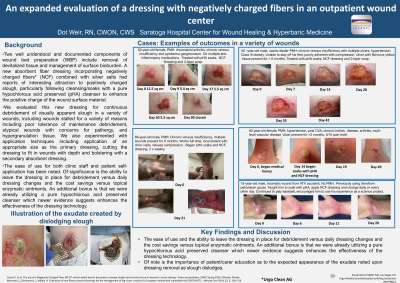Case Series/Study
(CS-169) An Expanded Evaluation of a Dressing with Negatively Charged Fibers in an Outpatient Wound Center
Friday, May 2, 2025
7:45 PM - 8:45 PM East Coast USA Time

Introduction: Two well understood and documented components of wound bed preparation (WBP) include removal of devitalized tissue and management of surface bioburden. A new absorbent fiber dressing incorporating negatively charged fibers* combined with silver salts has reports of interesting attraction to positively charged slough, particularly following cleansing/soaks with a pure hypochlorous acid preserved cleanser to enhance the positive charge.
Methods: We were evaluating this new dressing technology for continuous debridement of visually apparent slough in a variety of wounds. We then further expanded our use to other wounds stalled for a variety of reasons including poor tolerance of maintenance debridement, atypical wounds with concerns for pathergy, and hypergranulation tissue. We also experimented with application techniques including application of an appropriate size as the primary dressing, cutting the dressing to fit in wounds with depth and bolstering with a secondary absorbent dressing, as well as fenestrating the dressing followed by a secondary superabsorbent for heavily draining wounds.
Results: We found interesting and consistent results with liquefaction of slough and learned that education on expected visual results was important for the patient and other caregivers. We also noted improvement in wounds stalled for other reasons with suspicion of increased bacterial loads in the absence of signs and symptoms of infection leading to increased exudate and hypergranulation tissue. Five patient cases illustrating outcomes will be presented.
Discussion: The early successful results led us to expand our usage to wounds not necessarily thought to be necrotic but requiring improvement in WBP. The ease of use for both clinic staff and patient self-application has been noted. Of significance is the ability to leave the dressing in place for debridement versus daily dressing changes and the cost savings versus topical enzymatic ointments. An additional bonus is that we were already utilizing a pure hypochlorous acid preserved cleanser which newer evidence suggests enhances the effectiveness of the dressing technology.
Methods: We were evaluating this new dressing technology for continuous debridement of visually apparent slough in a variety of wounds. We then further expanded our use to other wounds stalled for a variety of reasons including poor tolerance of maintenance debridement, atypical wounds with concerns for pathergy, and hypergranulation tissue. We also experimented with application techniques including application of an appropriate size as the primary dressing, cutting the dressing to fit in wounds with depth and bolstering with a secondary absorbent dressing, as well as fenestrating the dressing followed by a secondary superabsorbent for heavily draining wounds.
Results: We found interesting and consistent results with liquefaction of slough and learned that education on expected visual results was important for the patient and other caregivers. We also noted improvement in wounds stalled for other reasons with suspicion of increased bacterial loads in the absence of signs and symptoms of infection leading to increased exudate and hypergranulation tissue. Five patient cases illustrating outcomes will be presented.
Discussion: The early successful results led us to expand our usage to wounds not necessarily thought to be necrotic but requiring improvement in WBP. The ease of use for both clinic staff and patient self-application has been noted. Of significance is the ability to leave the dressing in place for debridement versus daily dressing changes and the cost savings versus topical enzymatic ointments. An additional bonus is that we were already utilizing a pure hypochlorous acid preserved cleanser which newer evidence suggests enhances the effectiveness of the dressing technology.

.jpg)